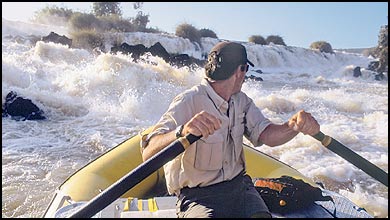For decades, no one has dared to run the treacherous lengths of the waters that helped launch the modern age of exploration. Civil war, freelance rebels, capricious bandits, irascible hippos, surly crocs, billions of malarial mosquitoes, and scores of rapids so deadly they're rated a suicidal Class VI—all have conspired to keep paddlers from navigating the full 4,160 miles of the storied, sacred, and cursed river Nile.
But this spring, two separate expeditions on the world's longest river—one led by Americans shooting an Imax film, the other by hardcore international paddlers backed by the global humanitarian group CARE—are well on their way to bagging a pair of historic prizes: the first simultaneous source-to-sea descents of the Nile along its two main tributaries.
On Christmas Day 2003, six paddlers on the four-month, 2,700-mile Imax/Nile First Descent Expedition launched from Lake Tana, Ethiopia, the headwaters of the Blue Nile, in an attempt to be the first to run the river all the way to the Mediterranean. On January 17, CARE's five-month, 3,473-mile Settle the Nile trip set out from Lake Victoria, the legendary source of the White Nile: The seven teammates plan to punch through more big water en route than anyone else on record, riding the river from Uganda to Khartoum, Sudan, where the White Nile and the Blue Nile converge, and on through Egypt to the coast.
Considering that both the White Nile and the Blue Nile have Everest-like ratings on the adventure scale, the efforts will be inspiring, even if the teams wash out.
“I can't begin to explain how incredible it's been already,” says Imax paddler Pasquale Scaturro, 50, a Colorado-based geophysicist and adventure guide, who led the 2001 expedition that put blind climber Eric Weihenmayer on the summit of Mount Everest. “We've had a couple of flips,” Scaturro told ���ϳԹ��� from Khartoum, Sudan. “We've had a hippo surface right in front of the raft. We've been shot at by shiftas [bandits]. We got arrested in the highlands.” (Ethiopian authorities didn't like the look of their travel permits.) “And a croc,” he added, “chomped one of our oars.”
Over on the CARE trip, Natalie McComb, a 31-year-old New Zealander, reported by e-mail that the crew has survived “frighteningly big water,” particularly in Uganda's Murchison Falls National Park, where there were “upwards of 35 to 40 rapids, and crocodiles and hippos by the dozen in each pool.” Couple that with the Sudanese war zones, she added, and it's no wonder these rivers still offer some unclaimed prizes.
If that seems improbable, it's important to remember that the Nile has stymied travelers for ages. Great explorers of the 19th century—people like British notable John Hanning Speke, who in 1858 discovered the source of the White Nile—struggled for years to map the river (or, in the case of David Livingstone, died trying). But by the 20th century, navigation was the sticking point: Rafters could run the river—but only with lengthy portages.
��
Today's teams are equipped with 16-foot self-bailing, inflatable rafts (along with hardshell kayaks), and they generally have to portage around only unbeatable obstacles like dams and some of the worst whitewater imaginable.
Harder to negotiate is the AK-47 factor. Sudan, through which both crews must travel, is embroiled in a 25-year-old civil war—between government forces and the Sudan People's Liberation Movement—a conflict in which civilians have been killed, maimed, and raped indiscriminately. The war has claimed an estimated two million lives in the past decade; before the recent lull in hostilities, securing safe passage through the country was nearly impossible. Both teams hired armed guards.
And though paddlers today often play on parts of the river—the White Nile in Uganda is a favorite kamikaze kayak spot for big-wave surfers like Brad Ludden—there's been a virtual shutdown of long-distance Nile trips for nearly 40 years, according to Richard Bangs, cofounder of California-based outfitter Mountain Travel Sobek. As a director of the Imax movie, slated for release in 2005, Bangs helped scout the gnarliest parts of the Imax journey.
A British military team completed a Blue Nile descent in 1968 but covered much of the journey on foot. And no one has tackled the entire White Nile since 1951, when American John Goddard and two friends made it to the sea from Lake Victoria's remotest headstream, in Burundi, but were forced to walk around the nastiest whitewater. “Taking nothing away from Goddard's accomplishment,” Bangs said, “there is no way he could have run Class V and VI rapids in the collapsible kayaks he had.”
Potentially fatal risks remain. The Imax paddlers—who plan to reach the coast by May—have been forced to portage several rapids and rappel down the side of Tis Isat (“Smoke of Fire”) Falls. The CARE crew (slated to finish by July) has had similarly scary spills, plus croc attacks.
Still ahead, though, are mammoth swamps, staggering heat, Egypt's Lake Nasser (famed for its headwinds), and the Aswan Dam (a tricky portage, to say the least). But the teams seem prepared for any challenge. Before setting out, Scaturro—afraid he'd get dinged for ignoring the real source of the Blue Nile—hiked up the Ethiopian Plateau to the river's trickling (unraftable) wellspring. Joining scores of pilgrims carrying gourds and canteens—many consider the water holy—Scaturro filled a Nalgene bottle and taped it shut.
“And I'm going to bring it with me,” he said, “the rest of the way.”


